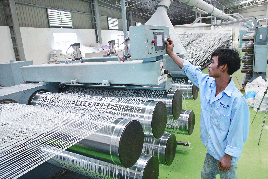INDOCHINA INTERNATIONAL CONSULTING CO., LTD
HO Add: 62L/36 Nguyên Hồng, Ward 11, Bình Thạnh District, HCMC - Vietnam
Biz Office Add: #48 Road No 11, Quarter 6, Hiệp Binh Chánh Ward, Thủ Đức, HCMC - Vietnam
®Source: http://viipip.com should be clearly quoted for any use of information extracted from our website.
Publication permit No: 60/GP-TTĐT , April 05, 2010.


Industrial enterprises are especially vulnerable to blackouts.
“The dry season shortage [from January to June] will possibly ease from 2011 to 2012, when key power projects become operational,” said Pham Le Thanh, general director of the state-run Electricity of Vietnam (EVN). According to EVN, four of the north’s major electricity generation projects – Son Dong thermal power plant, Cam Pha thermal power plant 1, Haiphong thermal power plant 1 and the expanded Uong Bi thermal power plant 1 – will not come online this year.
The 200-megawatt Son Dong thermal power plant, being developed by the Vietnam National Coal and Mineral Resources Group (Vinacomin), was due to generate power by June, 2009 but has suffered delays. The plant in Bac Giang province is generating electricity on a trial basis. It will be some time before the plant can run at full capacity.
The 600MW Cam Pha thermal power plant in Quang Ninh province, which is now running on a trial basis, was also due to go online in June, 2009 but has been set back until May, 2010. “The shortage of workers and equipment have been among the key obstacles for those plants,” Thanh said.
Slow site clearance and resettlement, the bidding process and the neglect of investors, who are participating in many other power projects, have also contributed to the delays. The Haiphong thermal power plant will start generating electricity from March next year while the expanded Uong Bi plant has not yet determined its operation schedule because of machinery problems.
According to the EVN, the northern region would need a further 2.5 billion kilowatt hours (kWh) of power in next year’s dry season. In the previous dry season, the north consumed about 20 billion kWh. “While the north’s new power sources are not on schedule, the system’s weak transmission capacity is another problem contributing to the shortage,” Thanh said.
Currently, up to 30 per cent of the power consumed in northern region has been supplied from power plants in the central and southern regions, as well as China. Most transformer stations and middle and low voltage transmission lines in the north have been running at their full capacity of about 3,600MW, 37.9 per cent lower than the transmission demand of 5,800MW, according to the Ministry of Industry and Trade (MoIT). In Hanoi alone, the total capacity of their 220kV transformer stations is about 1,500MW. In June 2009, the peak of the dry season, they had to transmit up to 1,670MW.
“The overloading will cause blackouts if there are no more new transmission stations or lines built soon,” said Nguyen Dinh Thang, deputy director of the Hanoi Industry and Trade Department’s Energy Management Unit. Figures from the EVN showed that a lot of transmission works in Hanoi and other northern provinces were running two to five years behind schedule.
- FDI capital continues to pour into Vietnam (6/11/2025 1:20:33 PM)
- Thanh Hoa receives good news: Preparing to have an additional industrial park of up to 470 hectares, creating jobs for nearly 30,000 people (6/11/2025 1:15:09 PM)
- Industrial Park Real Estate: Waiting for the New Generation of FDI (6/11/2025 1:10:15 PM)
- A wealthy Vietnamese city will have two special economic zones after the merger (6/11/2025 1:04:42 PM)
- 30 billion USD capital FDI in Việt Nam by 2025, a series of "ông big" races to expand the land fund (6/11/2025 12:55:26 PM)
- the 2nd largest city in the North will start construction on an international economic zone (6/11/2025 12:50:20 PM)
- Japanese giant Sumitomo continues to want to build an industrial park in the countrys fourth smallest province. (6/11/2025 12:40:45 PM)
- 3 foreign corporations want to invest billions of dollars in Ba Ria - Vung Tau (6/11/2025 12:34:30 PM)
- Lotte Group member starts construction of nearly 1,000 billion VND logistics center in the province with the most industrial parks in Vietnam (6/11/2025 12:33:26 PM)
- Forming a regional center for manufacturing spare parts and components (6/11/2025 12:24:08 PM)
- Vietnams first wafer factory is about to start construction (6/11/2025 12:19:09 PM)
- Dong Nai attracts foreign investors (6/11/2025 12:13:27 PM)
- Tay Ninhs largest industrial park welcomes a $150 million high-end knitted fabric factory project (6/11/2025 12:11:00 PM)
- (6/11/2025 12:09:10 PM)
- Vietnam will become a destination for Chinese investors in the future (11/6/2023 1:03:19 PM)

- FDI capital continues to pour into Vietnam
- Thanh Hoa receives good news: Preparing to have an additional industrial park of up to 470 hectares, creating jobs for nearly 30,000 people
- Industrial Park Real Estate: Waiting for the New Generation of FDI
- A wealthy Vietnamese city will have two special economic zones after the merger
- 30 billion USD capital FDI in Việt Nam by 2025, a series of "ông big" races to expand the land fund










 ADB: Vietnam’s 2009 GDP growth to be highest in South East Asia
ADB: Vietnam’s 2009 GDP growth to be highest in South East Asia MGM Grand Ho Tram: Vietnam’s First ‘Las Vegas Style’ Integrated Resort
MGM Grand Ho Tram: Vietnam’s First ‘Las Vegas Style’ Integrated Resort Nha Trang’s Twin Towers project licenced
Nha Trang’s Twin Towers project licenced Foreign investors still have good opportunities in Vietnam
Foreign investors still have good opportunities in Vietnam Sierra Wireless gets a foot in Vietnam’s ICT market
Sierra Wireless gets a foot in Vietnam’s ICT market